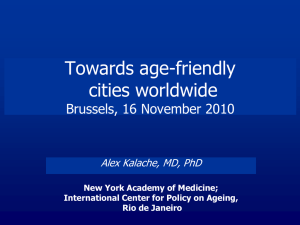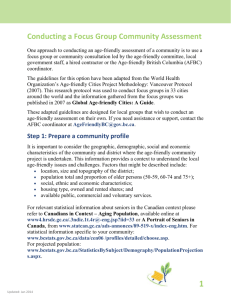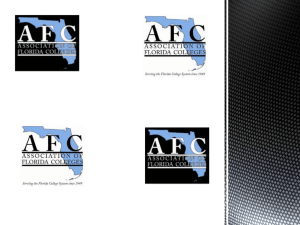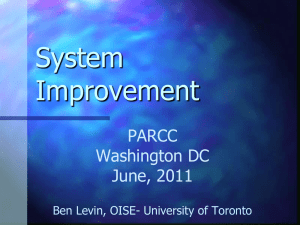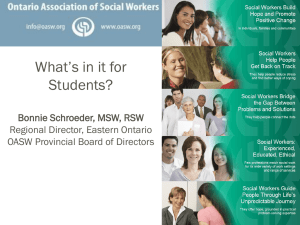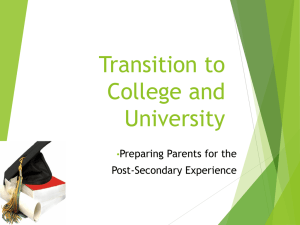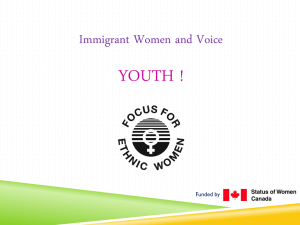Finding the Right Fit Age-Friendly Community Planning
advertisement
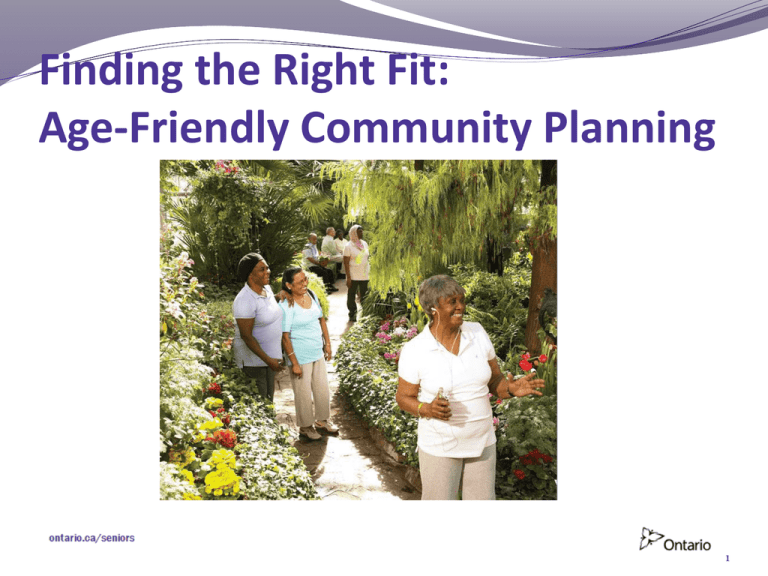
Finding the Right Fit: Age-Friendly Community Planning Finding the Right Fit Age-Friendly Community Planning 1 Presenters Dr. Margaret Denton, McMaster University Amanda Peters, McMaster University Ruth Wilford, Lakehead University Dr. Mary McGeown, Lakehead University 2 Outline of Presentation Age-friendly Cities and Communities What is happening in Ontario today What is the Government of Ontario doing to promote age-friendly communities Overview of the guide Finding the Right Fit: Agefriendly Community Planning Lessons learned on building an age-friendly community Contact Information 3 Aging Seniors in Ontario: A Demographic Imperative 2012 1.9 Million (14.9%) 2036 4.1 Million (25%) Is it a Silver Tsunami or a Triumph of Our Times???? 4 Age-Friendly Cities & Communities (AFC) AFC is an effective local policy approach for responding to demographic aging. AFCs establish policies, programs, services and infrastructure that supports the physical and social environments designed to enable older people to live in safety, enjoyment, good health and well-being while continuing to participate in society in meaningful ways. 5 Origins of the AFC Concept Person-Environment Fit (P-E fit) Roots in Environmental Gerontology discipline that suggests the ongoing relationship between people and their physical and social environment affects their quality of life (p-e fit). “The goodness of fit” For example: What is the p-e fit between older adults with mobility limitations and the public transportation system? What is the p-e fit between older adults who are isolated and lonely and the number of social activities in the community and why they are not able to attend? 8 Dimensions of an Age-Friendly City or Community 7 Heart of the Guide is the Age Friendly Checklist Tool for self assessment and a map to chart progress. Going beyond the checklist is possible. 8 What is Happening in Ontario Today? Twelve (12) Ontario communities are members of the WHO Global Network of Age-Friendly Cities and Communities: Central Region : Welland West Region: London, Waterloo, Windsor, Port Colborne, East Region: Ottawa, Kingston North Region: Thunder Bay, Sault Ste. Marie; Francophone Communities: Hearst, Noëlville, Verner. Sources: Ontario Seniors Secretariat (December 2013); MAREP AFC Communities Stories Website Many Communities have not begun Others are at various stages of the process (26): Central Region : Burlington, Mississauga, Collingwood, Halton, Hamilton, Richmond Hill, Toronto, Town of Caledon, York Region West Region: Brantford, Cambridge, Port Colborne, Welland, Erie St Claire, Guelph, Kitchener, Niagara Region, Oxford County, Petrolia, Sarnia-Lambton, Waterloo East Region: Kawartha Lakes ; Halliburton Highlands, Peterborough. Sharbot Lake Region North Region: Dryden, Sudbury Leadership Varies (based on contact information) In many cases Public and Private are working together! City/ Region including (N=16) Community Organization (e.g. Social Planning Council; Community Development) (N=2) Health Unit (e.g., District Health Unit, CCAC) (N=6) Seniors Group (e.g., Council on Aging, Senior Advisory Committee) (N=5) University (N=1) Unknown (N=3) What is the Ontario Government Doing to Promote Age-Friendly Cities & Communities Age-friendly communities (AFCs) is a key component of Ontario’s Action Plan for Seniors 11 Finding the Right Fit Age-Friendly Community Planning 12 Contents Section 1: Background Section 2: Using this Guide Section 3: Age-Friendly Community Dimensions Section 4: Defining Local Principles ‘A society for all ages is multigenerational. It is not fragmented, with youths, adults and older persons going their separate ways. Rather, it is ageinclusive, with different generations recognizing – and acting upon – their commonality of interest.’ Section 5: Custom Needs Assessment Section 6: Developing an Action Plan ~ Kofi Annan, Secretary General of the United Nations Section 7: Implementation and Evaluation Appendix I – V, Glossary, Business Tool 13 14 The Four Steps of the AFC Process Section 4 Section 7 Section 5 Section 6 15 Is this your community? Community 1 Starting a local AFC initiative Community 2 Developing a custom needs assessment Community 3 - Writing an Older Adult Plan, -Implementing - Evaluation Read Sections 2 and 3 to learn about AFC planning, then focus on Section 4, which presents tools for starting a local AFC initiative Review the p-e fit concept and AFC dimensions (Sections 2 and 3) and read Section 5 to see how to create a custom needs assessment. See Section 6 and 7 for resources about writing, implementing and evaluating an AFC action plan. 16 Outdoor Spaces and Public Buildings Respect and Social Inclusion Transportation Civic Participation and Employment Housing Communication and Information Social Participation Community Support and Health Services 17 Section 4 Step 1: Defining Local Principles Objectives Create structure around local initiative Determine which AFC dimensions are most relevant to your community Tasks 1. Form a steering committee 2. Create guiding principles 3. Build partnerships 4. Create and age-friendly community profile 5. Discuss priorities 18 Section 5 Step 2: Custom Needs Assessments Objectives Collect more detailed information about age-friendly priorities in your community Identify your community’s personenvironment (p-e-) fit Tasks 1. Examine your tool set 2. Create a draft list of questions 3. Create person-environment question pairs 4. Finalize the needs assessment 19 Appendix III: Age-Friendly Community and Quality of Life Instrument Studies 20 Create a Draft List of Questions 21 Section 6 Step 3: Developing an Action Plan Objectives Lay out specific strategic actions that address the key gaps in your community’s p-e fit Tasks 1. Analyze your needs assessment data 2. Identify specific strategies that address gaps identified by your needs assessment 3. Compile strategies into an action plan with specific goals and objectives 22 Section 7 Step 4: Implementation and Evaluation Objectives Identify primary users Determine the purpose of your evaluation – summative vs. formative Identify methods and measurement Interpret findings and make judgments Develop future AFC plans Improve existing AFC action plan Tasks 1. Establish a direction for monitoring and evaluating the success of the plan 2. Determine an appropriate monitoring mechanism 3. Specific goals and objectives 23 Additional Materials Appendix I: Key Resources Glossary of Acronyms Is Your Business Age-Friendly? Reference List COMMUNITY STORIES Acknowledging and learning from the successes of AFC initiatives is key to the continued success of the movement. To achieve this, the guide highlights ten case studies (pages 18, 26, 36, 44, 49, 55, 56, 59, 64 and 66) that explore different approaches communities have taken to improve their age-friendliness. Besides these, many community stories on the Murray Alzheimer Research and Education Program (MAREP) website (http://afc.uwaterloo.ca) discuss the positive effects that AFC planning is having across Ontario. 24 Some Lessons Learned in Moving to an Age-friendly Community AFC Older adults must be involved in all stages of the process. To be successful, a-f initiatives must be both bottoms up and top down (City, Region, as well as community led seniors group). It must involve multiple stakeholders, both public and private. Look for Champions or advocates to champion AFC and build alliances Both outside the City and Inside Be aware of current initiatives that may contribute to a-f (e.g. Accessibility for Ontarians with Disabilities Act, Municipal Plans, Complete Streets, Vibrant Communities etc.) Use an AFC lens to assess current policies and practices, organizations and services. continued Where is the accountability? Need a strategic older adult plan to achieve AFC Need a community plan Municipality responsible for infrastructure & some services Community responsible for other aspects Two levels of government (City/Region) must develop an over arching strategy Evaluation (need indicators, measures) Sustainability AFC initiative must be sustainable across political regimes AFC must be sustainable over time. Start up and core funding is critical. Contact Information McMaster University Waterloo University Lakehead (Central & Eastern Ontario) (Western & Eastern Ontario) (Northeast/Northwest Ontario) Margaret Denton mdenton@mcmaster.ca 905-525-9140 ext 23923 905-379-5099 Amanda Peters petera8@mcmaster.ca John Lewis j7lewis@uwaterloo.ca 519-8884567 ext 33185 University Mary McGeown mmcgeown@lakeheadu.ca 807-766-7123 Mark Groulx Mark.Groulx@gmail.com ***Content Expert on Customized Needs Assessments Using the University of Waterloo Data Base 27

